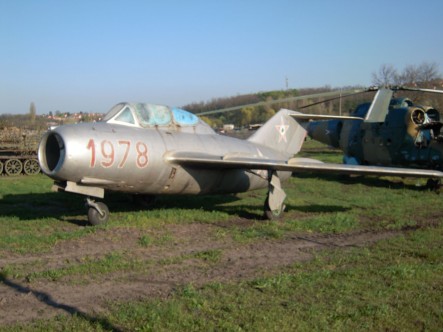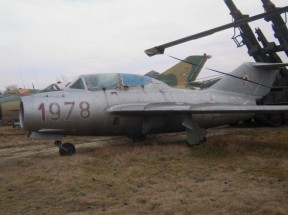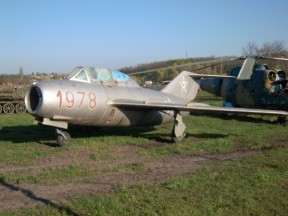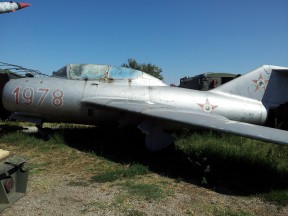Vehicle data sheet
MIG-15 UTI
Manufacturer: ,

| Type: Airplane | Weight: 5 t |
| Produced: 1949 | Size: Length 10 m, Height 4 m |
| Number built: 12000 | Engine: Turbojet, 10800 HP |
| Crew: 1 | Speed: 1075 km/h |
Description
This is a two-seat trainer version of the mig 15.
Mikoyan and Gurevich had been impressed with the Biritish-made Rolles-Royce "Nene" turbojet engine for some time, however, being on opposite sides of the Iron Curtain made getting a hold of the technology very unlikely. Stalin himself is quoted as saying, "What fool will sell us his secrets?" Apparently that fool was Minister of Trade, Sir Stafford Cripps. With the blessing of the Labor party, the Ministry of Trade licensed the Soviets schematics of the Nene. These plans were immediately reverse-engineered to create a nearly-identical motor with 4,800 pounds of thrust, dubbed the RD-45, which was then installed in the I-310 to create the MiG-15.
With the engine upgrade, the MiG-15 became an agile single-seat interceptor measuring 33 feet long with a 33 foot wingspan. It was, after all, designed to hunt the B-29 Super Fortress and B-52 Bomber, however, despite the turbojet engine, the MiG-15 was unable to reach supersonic flight. It could dive at supersonic speeds, sure, but the plane's "all-flying tail" caused massive instability as the aircraft approached Mach 1. In fact, the plane was designed to automatically deploy air-brakes in the event that the craft reached Mach .92. In addition, the first run production models had such great variances in their assembly, that they tended to roll lazily left or right while in flight. Ground crews had to install and calibrate aerodynamic trimmers to correct the faults. These issues were corrected about a year after the MiG-15's debut in 1949 with the creation of the MiG-15bis. Since the MiG-15 was built as a bomber hunter, it did not carry air-to-air missiles. Instead, the aircraft was outfitted with a pair of 23mm and one 37mm cannon. They packed a punch, but had a limited range, which made them great for taking down huge aircraft like the B-29 but not against its arch-rival, the F-86 Sabre.
The MiG-15 did have the advantage of a higher operating ceiling than the F-86 which allowed Soviet pilots to outmaneuver their opponents. Despite the MiG-15's supersonic shortcomings, it operated extensively during the Korean War against UN forces, typically to great success. It's swept-wing design proved to be a major improvement and allowed the Soviets to dominate the UN's straight-wing craft during daylight hours.
| ID | Vehicle name | Category | Condition | Available for rent | Available for sale | Location |
|---|---|---|---|---|---|---|
| MT000328 | MIG-15 UTI | Airplane | intact,no parts inside | Budaörs |



